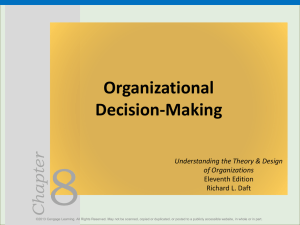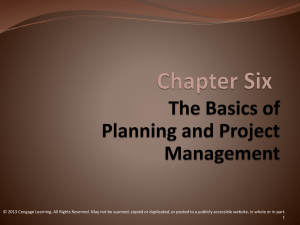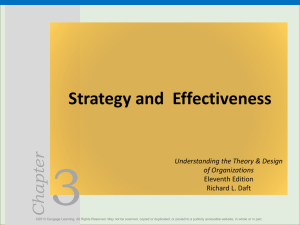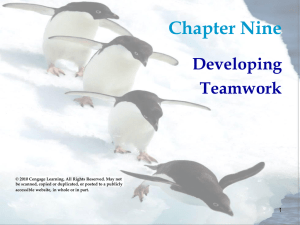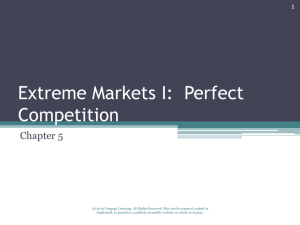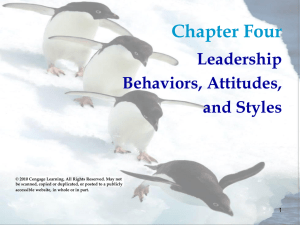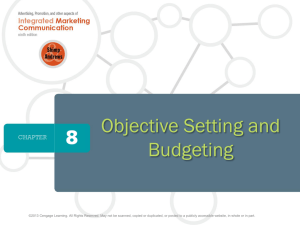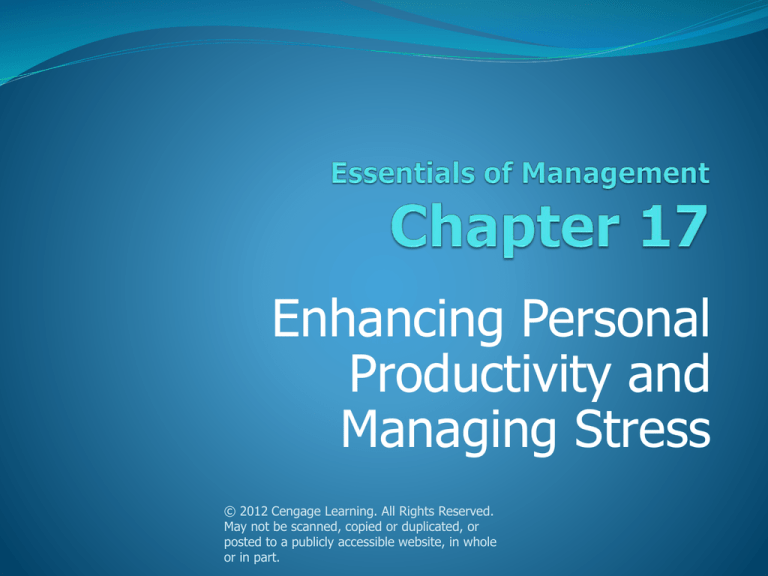
Enhancing Personal
Productivity and
Managing Stress
© 2012 Cengage Learning. All Rights Reserved.
May not be scanned, copied or duplicated, or
posted to a publicly accessible website, in whole
or in part.
Improving Work Habits and Time
Management
Demand for high productivity among managerial
workers has never been higher.
High productivity allows for smoother personal life
and reduces stress from being out of control.
The techniques and attitudes outlined next are
helpful for enhancing productivity.
© 2012 Cengage Learning. All Rights Reserved.
May not be scanned, copied or duplicated, or
posted to a publicly accessible website, in whole
or in part.
Improving Work Habits and Time
Management, continued
Develop a mission, goals, and a strong work ethic.
(A purpose and certain values can propel you toward
productivity.)
Clean up your work area and sort out your tasks. (A
messy work areas leads to wasted time and neglect,
yet the issue of avoiding clutter is controversial.
Being super-organized can reduce flexibility. Also,
out of sight files can be neglected. )
© 2012 Cengage Learning. All Rights Reserved.
May not be scanned, copied or duplicated, or
posted to a publicly accessible website, in whole
or in part.
Improving Work Habits and Time
Management, continued
Prepare a to-do list and assign priorities. (Taking
care of easy-to-do tasks is often relaxing. A checklist
can help avoid potentially dangerous errors.)
Streamline your work. (Eliminate as much low-value
work as possible, and focus on activities that add
value for customer.)
Work at a steady, rapid pace. (Yet, major decisions
should not be made rapidly.)
© 2012 Cengage Learning. All Rights Reserved.
May not be scanned, copied or duplicated, or
posted to a publicly accessible website, in whole
or in part.
Work Habits and Time Management,
continued
a.
b.
c.
d.
Minimize time wasters and interruptions.
Time diverted from unproductive activity can be
invested in productive work.
Can also avoid working extra hours.
Internet surfing a big problem, as is shifting from
one task to another.
Interruptions may require re-launching but some
are necessary or helpful.
© 2012 Cengage Learning. All Rights Reserved.
May not be scanned, copied or duplicated, or
posted to a publicly accessible website, in whole
or in part.
Work Habits and Time Management,
continued
a.
b.
c.
Concentrate on one task at a time.
Productive managers focus on task facing them at
the time.
Intense concentration leads to sharp judgment
and analysis, fewer errors.
Multitasking best for routine tasks, and may lead
to serious errors on key tasks.
Concentrate on high-output tasks (those with big
potential payoff).
© 2012 Cengage Learning. All Rights Reserved.
May not be scanned, copied or duplicated, or
posted to a publicly accessible website, in whole
or in part.
Improving Work Habits and Time
Management, continued
Do creative and routine tasks at different times.
(Tackle creative tasks when you are typically at your
best.)
Stay in control of paperwork, e-mail, and voice mail.
(Not taking care of these items leads to being out of
control.)
Make effective use of office technology. (Invest time
saved into productive work, such as customer
problem solving.)
© 2012 Cengage Learning. All Rights Reserved.
May not be scanned, copied or duplicated, or
posted to a publicly accessible website, in whole
or in part.
Improving Work Habits, and Time
Management, continued
Practice the mental state of peak performance.
(Achieve maximum results with minimum effort, be
at ease.)
Take naps or meditate. (Brief naps recharge person,
and also reduce stress.)
Work smarter, not harder. (Plan carefully, and
discharge work imaginatively.)
Build flexibility into your system. (Be able to take
care of emergencies, and relax.)
© 2012 Cengage Learning. All Rights Reserved.
May not be scanned, copied or duplicated, or
posted to a publicly accessible website, in whole
or in part.
Why People Procrastinate
1.
2.
3.
4.
5.
6.
Fear of failure
Desire to avoid uncomfortable tasks
Not seeing a meaningful reward ahead
Dislike of being controlled
Enjoying excitement from rushing to meet a
deadline
Having a negative emotional state such as being
self-defeating
© 2012 Cengage Learning. All Rights Reserved.
May not be scanned, copied or duplicated, or
posted to a publicly accessible website, in whole
or in part.
Approaches to Reducing and Controlling
Procrastination
1.
2.
3.
4.
5.
6.
7.
Break task down into smaller units.
Make a commitment to others.
Reward yourself for achieving milestones.
Calculate the cost of procrastination.
Post encouraging notes to yourself.
Counterattack (force self to do bad task).
Put a progress chart in your work area.
© 2012 Cengage Learning. All Rights Reserved.
May not be scanned, copied or duplicated, or
posted to a publicly accessible website, in whole
or in part.
The Nature of Stress and Burnout
Job stress and burnout can be major impediments to
a successful career.
Worker stress costs $300 billion annually including
lost productivity, worker compensation, and healthcare costs.
Stress is physical and mental condition that stems
from perceived threat that cannot be dealt with
readily.
© 2012 Cengage Learning. All Rights Reserved.
May not be scanned, copied or duplicated, or
posted to a publicly accessible website, in whole
or in part.
Job Performance Consequences of
Stress
Hindrance stressors have a negative effect on
motivation and performance.
Challenge stressors have positive effect on
motivation and performance.
Perception determines whether stressor is hindrance
or challenge.
Right amount of stress required to keep person
mentally and physically alert.
© 2012 Cengage Learning. All Rights Reserved.
May not be scanned, copied or duplicated, or
posted to a publicly accessible website, in whole
or in part.
Job Burnout
Emotional, physical, mental exhaustion resulting
from chronic stressors
Cynicism, apathy, indifference, and hopelessness are
major symptoms.
Burnout in form of emotional exhaustion leads to
lowered job performance.
Absence of ample positive feedback and other
rewards linked to job burnout.
Less burnout if leader is perceived to be charismatic
© 2012 Cengage Learning. All Rights Reserved.
May not be scanned, copied or duplicated, or
posted to a publicly accessible website, in whole
or in part.
Factors within Individual Contributing to
Stress and Burnout
Type A people (hostile, impatient) prone to high
levels of job stress.
People with internal locus of control are less stress
prone.
People with high expectations, and those who need
constant excitement, are potential burnout victims.
Large study found that internal locus of control
associated with well-being.
© 2012 Cengage Learning. All Rights Reserved.
May not be scanned, copied or duplicated, or
posted to a publicly accessible website, in whole
or in part.
Adverse Organizational Conditions
Contributing to Stress and Burnout
Work and information overload (Death from
overwork, or karoshi, reported in Japan.
Communication overload can result in attention
deficit trait.)
Extreme conflict (including office politics, short lead
times, and job insecurity)
Role ambiguity (confusing or poorly-defined
expectations)
Limited control over work (despite high demands—
job demand-job control model)
© 2012 Cengage Learning. All Rights Reserved.
May not be scanned, copied or duplicated, or
posted to a publicly accessible website, in whole
or in part.
Adverse Organization Conditions, continued
a.
b.
c.
Adverse interactions with customers and emotional
labor (Latter refers to having to control expression
of emotion to please or avoid displeasing a
customer.)
Work-family conflict
Person has to perform multiple roles
People bring work into home and home into work
Flexible working hours can help
© 2012 Cengage Learning. All Rights Reserved.
May not be scanned, copied or duplicated, or
posted to a publicly accessible website, in whole
or in part.
Stress Management Techniques
Everybody experiences stress.
How you manage stress can be the key to your well
being.
Organizations can play a major role in remedying
stress by correcting negative conditions.
Focus here is on what individuals can do to manage
stress and burnout.
© 2012 Cengage Learning. All Rights Reserved.
May not be scanned, copied or duplicated, or
posted to a publicly accessible website, in whole
or in part.
Methods for Control and Reduction of
Stress
1.
2.
3.
4.
5.
6.
Get social support.
Improve your work habits
Develop positive self-talk.
Hug the right people.
Demand less than perfection from yourself.
Strive not to neglect aspects of life outside of
work.
© 2012 Cengage Learning. All Rights Reserved.
May not be scanned, copied or duplicated, or
posted to a publicly accessible website, in whole
or in part.
Symptom Management for Stress
Reduction
1.
2.
3.
Make frequent use of relaxation techniques
including meditation. (The relaxation technique
works well, and so does visualizing a pleasant
fantasy.)
Get appropriate physical exercise. (Very important
for heavy business travelers.)
Try to cure the hurry sickness. (Enjoy the present
for its own sake.)
© 2012 Cengage Learning. All Rights Reserved.
May not be scanned, copied or duplicated, or
posted to a publicly accessible website, in whole
or in part.
Removal of the Stressor
Include actions and reappraisals of the situation that
provide stressed person some relief from the
stressor.
Eliminating the stressor is the most effective escape
technique.
Mentally block out stressful thought.
Strategic method is to identify work skills, and find
work to match skills.
© 2012 Cengage Learning. All Rights Reserved.
May not be scanned, copied or duplicated, or
posted to a publicly accessible website, in whole
or in part.



